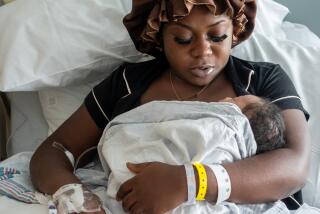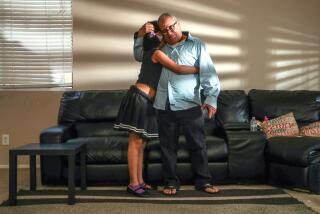A family left behind by the H1N1 virus
On a rainy January day, Karen Romo, 15, feeds her five younger brothers and sisters an early dinner and tidies the kitchen while waiting for her father to return from work. One of the children vacuums the living room, maneuvering around a large box of diapers. Another sibling holds the baby.
When the father, Miguel, arrives home, he’s carrying a couple of bags of groceries, enough for a day or two. He rubs his youngest son’s head affectionately, and pulls the infant into his arms.
He seems bewildered by the turn his life has taken. “I miss my wife very much,” says Miguel, a quiet man who speaks halting English. Looking around the cramped living room, he adds: “She was half my life.”
Just inside the door of the two-bedroom, second-floor Santa Ana apartment sits a tabletop shrine crowded with devotional candles. The candles depict Our Lady of Guadalupe and the Sacred Heart of Jesus; dried roses droop in a vase. It pays forlorn but faithful tribute to Virginia Romo, the wife and mother who died in July at age 38.
The cause of death was pneumonia, believed to have been a complication of the H1N1 virus she caught last spring at the dawn of the outbreak. One of about 11,000 swine flu deaths nationwide, Romo’s in many ways typifies the pandemic. She was young, poor, pregnant and Latina.
“She was always so healthy,” says Miguel, 40, who is now raising six children -- ages 15 years to 7 months -- on his own. “I don’t know what happened. I don’t understand.”
He gestures to the apartment’s homey living room, decorated with elaborate draperies, framed paintings and religious icons. “Virginia did everything for us,” he says. “She was always so happy.”
As health officials begin to tally the score card from the 2009 pandemic, some facts are becoming clear. The virus was not as lethal as feared; most of the 55 million cases in the U.S. were mild. Nor did it primarily fell the elderly and infants, as most flu viruses do. Instead, swine flu targeted younger adults, with the majority of deaths among people ages 18 to 64.
It saved its worst for pregnant women.
They have been hospitalized at four times the rate of the general population and have died at six times the average rate, according to various estimates. In a study of 63 pregnant women in California who were hospitalized with H1N1 between April 23 and Aug. 11,61 were so sick they were placed in intensive care. Seventeen died.
“The deaths among pregnant women are devastating. This is supposed to be a great time in their lives. Then the mom dies and the baby survives,” says Dr. Janice Louie, chief of the influenza and respiratory diseases section of the California Department of Public Health. She was author of a study, published in January in the New England Journal of Medicine, analyzing the effects of H1N1 on pregnant and postpartum women in California.
In many of the lethal cases in pregnant women, the illness struck swiftly, leaving families and widowed husbands in shock. Six months after his wife’s death, Miguel still sees reminders of her everywhere. Her prenatal vitamins sit on the kitchen counter.
He manages to care for the children, though he works weekdays at a factory that makes tortilla machines and recently resumed three evening shifts a week as a busboy at a Newport Landing restaurant. A friend of Virginia’s who lives with the family cares for the baby, the 5-year-old twins and her own two children until Karen comes home from school. When the friend leaves for her job, Karen is in charge until Miguel returns.
“I used to work five or six nights at the restaurant, but now I have to watch the babies,” Miguel says as the twins pester him to go out for doughnuts. “My older daughters have to go to school, and they have homework to do.”
It’s been hard to explain to the twins what has happened, he says.
“At first, I told them their mother was in Mexico. Now, I’m trying to explain it to them, little by little. I tell them, she’s with God in the sky. But they still say, ‘Where’s Mama?’ ”
A sticker on the door to the family’s apartment reads, “Este Hogar es Catolico.” This home is Catholic.This home is Catholic. Devoted to their faith, Miguel and Virginia welcomed every child as a gift from God.
They met as children in the village of San Miguel el Alto in Jalisco, Mexico. Karen was born there. The family moved to Santa Ana where Gabriela, 14; Cristian, 12; and 5-year-old twins Giovanni and Yareli were born. In late 2008, Virginia became pregnant again.
For most of her pregnancy, Virginia felt fine. Although she was overweight, she was healthy; she had even quit smoking. Then, in the late spring, she came down with what appeared to be a bad cold. In mid-June, her cough turned nasty. She complained of chest and back pain. She often lay in bed all day with the lights off instead of bustling around the apartment cleaning. Normally unfazed by the noise in a home with five kids, she asked Karen to keep the children quiet.
She had obtained regular prenatal care with Medi-Cal insurance, and she made a few visits to a physician about her respiratory symptoms. She soon began to complain of shortness of breath. On July 3, one month before the baby was due, Virginia’s condition worsened.
“When I got home, my daughter told me to take Virginia to the hospital,” Miguel recalls. “Virginia was scared. She said she couldn’t breathe.”
The couple went to Western Medical Center in Santa Ana, and Virginia was admitted at 2 a.m. on July 4, about six weeks after her first symptoms and about 10 days after they became severe. The doctor noted the symptoms on the admission summary: coughing up yellow sputum, fever of 101, shortness of breath. A chest X-ray showed lung congestion.
Doctors gave her oxygen and IV fluids and began to run tests.
‘I’m sure this was H1N1,” says Virginia’s obstetrician, Dr. David Su, of Santa Ana. “H1N1 had just come around. We didn’t know which group of people it would hit. It’s not like the typical flu. Every year, we have pregnant patients with flu and bronchitis and coughs and colds. They don’t usually die.”
Early on July 5, Miguel got a call from the hospital. “They said, ‘Can you be here in 10 minutes? We have to do surgery right away,’ ” Miguel recalls. He rushed to the hospital. Virginia had gone into acute respiratory distress. The baby was delivered in an emergency caesarean section, a few weeks premature but at 5 pounds, 8 ounces otherwise healthy. Virginia was intubated and taken to intensive care.
“These women are so sick, a lot of them have to be delivered in the ICU,” Louie said of the H1N1 pregnancy cases. “As the fetus grows, it pushes up on the lungs, and a pregnant woman has less room to expand. This predisposes them to not being able to cough as well.”
Hormones and the immune system also change during pregnancy, which makes it harder for pregnant women like Virginia to fight infection. Further, statistics released earlier this month by the state Department of Public Health show that in California, Latinos have been twice as likely as whites to die from H1N1, in part because they have less access to healthcare and are more likely to have other chronic health problems or wait longer to seek help.
Virginia was rarely conscious after being admitted to the hospital. Over the next few weeks, doctors diagnosed pneumonia and gave her antibiotics and the antiviral drug Tamiflu, which is recommended for H1N1 treatment in pregnant women as well as other patients. She had aggressive lung treatments and was placed in a bed that could be rotated to turn her upside down, creating more room in her lungs and allowing mucus to dislodge.
“We gave her everything; it just got worse and worse,” Su says. “The lung tissue was just shot.”
Several mornings a week, Miguel would drop Karen off at the hospital and she would spend the day at her mother’s bedside.
“It was so hard to see her there. I would talk to her and just hope she would be listening to me,” Karen says. “I would tell her, ‘The baby is fine; just get better.’ ”
Virginia died alone early on July 22.
Six days later, the U.S. Centers for Disease Control and Prevention issued its first bulletin alerting doctors to an increased risk of complications among pregnant women with H1N1.
The baby -- Virginia -- is beautiful. Everyone says so. She’s a good baby, Karen says. She only fusses a little now and then because she’s teething. The children vie for turns holding her.
Karen recalls how thrilled her mother was at the prospect of another child. She has resolved to make sure her baby sister knows this.
“When she took the pregnancy test, she was so happy,” Karen recalls. “She said it was probably her last baby because of her age.”
As she waits for her father on this rainy day, Karen sweeps rice and Froot Loops off the plates, washes them and places them in the dish rack. She opens the door and yells to the younger children to stay out of the street. It’s sunset, the showers have stopped, and food vending trucks selling tortillas and candy are lining up at the curb.
A good athlete, Karen had wanted to play softball after school this spring, but now that’s not possible. She still manages to get good marks in her 10th-grade classes and loves science and math.
Someday, she says, she would like to be a midwife.
More to Read
Sign up for Essential California
The most important California stories and recommendations in your inbox every morning.
You may occasionally receive promotional content from the Los Angeles Times.










